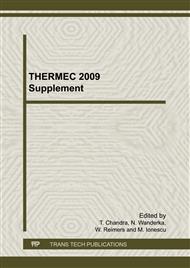p.325
p.331
p.337
p.342
p.347
p.353
p.359
p.365
p.371
Quench Sensitivity and its Effect on the Microstructure and Mechanical Properties of an Al-Zn-Mg-Cu Aluminum Alloy
Abstract:
The high mechanical properties in 7xxx aluminum alloy are obtained by controlling the precipitation hardening microstructure. In this work, the relationship between the microstructures and mechanical properties of 7A04 (Al-Zn-Mg-Cu) aluminum alloy during isothermal aging at 140 oC after different quenching rates has been studied in order to find its useful hardening conditions. The as-extruded samples were solution heat treated at 480 oC and cooled in air, 70 oC water, 40 oC water and 0 oC ice water. Tensile test were performed and the ultimate tensile strength and percentage of elongation were obtained. The difference in the amount of precipitates is known by DSC and the morphology of the precipitates is characterized by TEM. The results indicate that the artificial age hardening response is strongly dependent on the quenching rate. Lower quenching rate results in lower tensile strength but higher percentage of elongation in the peak age condition, and this corresponds to the difference in the size and number density of the precipitates. It is concluded that the highest ultimate tensile strength is obtained in the fastest quenching rate in 0 oC ice water (up to 870Ks-1) while stable and high percentage of elongation is achieved in the intermediate quenching rate (about 226 Ks-1).
Info:
Periodical:
Pages:
347-352
Citation:
Online since:
January 2010
Authors:
Keywords:
Price:
Сopyright:
© 2010 Trans Tech Publications Ltd. All Rights Reserved
Share:
Citation:


